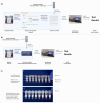Validation of a simplified HPV genotyping assay designed for cervical screening in low-resource settings
- PMID: 39745462
- PMCID: PMC11837489
- DOI: 10.1128/jcm.01639-24
Validation of a simplified HPV genotyping assay designed for cervical screening in low-resource settings
Abstract
Human papillomavirus (HPV) genotype predicts cervical cancer risk, and genotyping could help guide the management of HPV positives as part of cervical screening. An isothermal amplification HPV extended genotyping test (ScreenFire HPV RS assay) can assay up to 96 samples/controls in 1 hour plus preparation time. A novel format with pre-aliquoted reagents and an anti-contamination component (Zebra BioDome) could simplify the HPV testing process and reduce the chances of post-amplification contamination. We validated the Zebra BioDome formulation prior to its clinical use. Residual provider-collected cervical samples (n = 450) from a population-based study in rural Nigeria were retested with ScreenFire, once using the standard assay version (liquid reagents combined onsite) and twice with Zebra BioDome. HPV results with adequate DNA (N = 427) were analyzed channel-by-channel and using the cervical cancer risk-based hierarchy of HPV type channels (HPV16, else 18/45, else 31/33/35/52/58, else 39/51/56/59/68, else high-risk HPV negative) to evaluate Zebra BioDome repeatability and accuracy against the standard version. Zebra BioDome reduced the number of pipetting steps to run the ScreenFire HPV assay. Following amplification, the BioDome material formed a sealant layer above the reaction components. Zebra BioDome had excellent repeatability and agreement with the standard version, both at the channel-specific analysis (positive percent agreement between 88.4% [HPV39/51/56/59/68] and 100% [HPV16]; negative percent agreement between 97.8% [HPV31/33/35/52/58] and 100% [HPV39/51/56/59/68]) and hierarchical analysis (overall agreement 97.2%). The assay version utilizing Zebra BioDome performed similarly to the previously validated standard version of the ScreenFire HPV assay and is now undergoing field evaluation. This solution has the potential to reduce assay preparation time and risk of contamination, providing a simpler, low-cost, near-point-of-care HPV testing and extended genotyping solution for cervical screening in lower-resource settings. The potential application of Zebra BioDome technology to other PCR assays should be considered.
Importance: This work validates a novel pre-packed formulation for the ScreenFire human papillomavirus (HPV) assay, which has the potential to simplify the HPV testing process and to reduce the chances of post-amplification contamination, providing a simpler, low-cost, near-point-of-care HPV testing, and extended genotyping solution for cervical screening in resource-limited settings as part of the ultimate public health goal to accelerate cervical cancer prevention. This technology can also have broad applications for other DNA amplification assays beyond HPV.
Keywords: HPV genotyping; HPV testing; LMICs; cervical cancer screening; point-of-care.
Conflict of interest statement
The authors declare no conflict of interest. Atila BioSystems had no role in the design, analysis, interpretation or drafting of this article.
Figures

References
-
- International agency for research on cancer. World Health Organization . 2021. GCO Cancer Today. Available from: https://gco.iarc.fr/today/
-
- World Health Organization . 2020. Global strategy to accelerate the elimination of cervical cancer as a public health problem. Available from: https://www.who.int/publications/i/item/9789240014107
-
- World Health Organization . 2021. WHO Guideline for Screening and Treatment of Cervical Pre-Cancer Lesions for Cervical Cancer Prevention, Second Edition. Geneva. World Health Organization. Available from: https://www.who.int/publications/i/item/9789240030824 - PubMed
-
- de Sanjosé S, Serrano B, Tous S, Alejo M, Lloveras B, Quirós B, Clavero O, Vidal A, Ferrándiz-Pulido C, Pavón MÁ, Holzinger D, Halec G, Tommasino M, Quint W, Pawlita M, Muñoz N, Bosch FX, Alemany L, RIS HPV TT, VVAP and Head and Neck study groups . 2018. Burden of human papillomavirus (HPV)-related cancers attributable to HPVs 6/11/16/18/31/33/45/52 and 58. JNCI Cancer Spectr 2:pky045. doi:10.1093/jncics/pky045 - DOI - PMC - PubMed

